
Features
Alternative Fuels
Energy
Optimizing energy options: It’s only one of several trends in Leamington region review
June 9, 2008 By Dave Harrison
Alternative energy projects, niche
products and improved water management strategies are among recent
trends within the Ontario vegetable greenhouse sector.
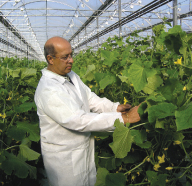
|
| OMAFRA greenhouse vegetable specialist Shalin Khosla; (bottom) Kurt and Lina Grass of Rainbow Acres |
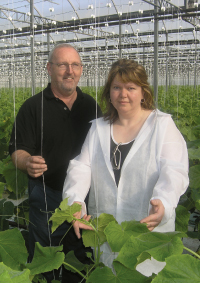 |
Alternative energy projects, niche products and improved water management strategies are among recent trends within the Ontario vegetable greenhouse sector.
Growers have become quick studies in the field of alternative fuels, and in particular, biomass combustion. Rising prices have led many growers to study alternatives to natural gas, the sector’s staple for many years.
Heating accounts for between 35 and 40 per cent of production costs for many vegetable growers. Adopting biomass technologies has helped lower those costs. A number of growers are into at least their third year using biomass boilers.
“Growers are now much more comfortable with these systems,” noted Ontario Ministry of Agriculture, Food and Rural Affairs greenhouse vegetable specialist Shalin Khosla. They’re experiencing far fewer shutdowns or other problems. “It’s working well for them.”
OMAFRA has hosted a number of well-attended workshops to discuss various combustion topics, “and how growers can best maximize their systems.”
New material handling systems have minimized jamming problems. “They ensure a more uniform product goes into the combustion chamber,” Khosla said. “The better the fuel source going into the combustion chamber, the better the heating results.”
It’s important to secure a good source of the fuels. It’s also best to have two sources, in case one supplier has a problem when the fuel is needed most. “It’s so important to have a backup.”
Onsite storage is also important. OMAFRA is preparing a factsheet (Use of Biomass for Heating Greenhouses in Ontario – Rules and Best Management Practices) on biomass storage that will soon be available on its website.
Conservation is the second part of the energy equation. A major energy audit of 22 greenhouses throughout Ontario – both ornamental and vegetable – was conducted in 2006. It identified key energy-saving features in both glass-covered and polyethylene-covered structures. Growers are checking these benchmarks to see what will work best for them. “The study pinpointed areas that need to be worked on.”
The study, conducted by Ag Energy Co-operative, was sponsored by The Ontario Greenhouse Alliance (TOGA) and its member associations, the Ontario Greenhouse Vegetable Growers (OGVG) and Flowers Canada Ontario, and OMAFRA.
Many growers have insulated their main heating lines and sub-mains to ensure the heat is directed into the crop, and not lost in hallways and walkways. In addition, improved computerized energy management programs are being utilized to optimize the benefits of venting.
More growers are choosing to use hot water boiler systems, a trend that began in the late 1990s. During the daytime, when there’s not much demand for heat, they can run the boilers and use the CO2 in the greenhouse. The hot water is stored for use at night.
EXPANSION RATES HAVE LEVELLED OFF
Expansion cooled in the province last year, with about 60 acres of new construction. “There will be some expansion this year,” said Khosla, “but it will be nowhere near the high numbers we had in the past.”
There are currently about 1,800 acres of greenhouse vegetables grown in Ontario. Of that, 50 per cent is in tomatoes, 27 per cent is in peppers, and 23 per cent is cucumbers.
It’s interesting to note the growth of the pepper sector. As recently as the late 1990s, there were only about 10 acres in the province. “The growth has been quite dramatic.”
Of the total greenhouse vegetable acreage in the province, some 1,600 acres are concentrated in the Chatham-Kent and Essex regions. Well over half the Canadian greenhouse vegetable industry is located here.
The average size of a greenhouse vegetable operation has grown to 7.8 acres, up from 7.3 acres last year. “The larger size means improved efficiencies within your existing infrastructure,” said Khosla.
Growers are still expressing interest in glass construction. Last year, the new acreage was all in double poly, but it’s possible there will be some glass projects this year. One of the benefits of glass is that crops come into production about a week to 10 days earlier. However, some growers feel double poly works better in the summer in buffering the heat. “Both systems produce very well, as long as you handle them correctly,” Khosla said. “There are advantages with both of them. It all comes down to grower preference.”
Another trend is diversification. Growers are increasingly tapping into niche markets, including different colours, sizes and shapes of the major crops. Mini-cucumbers and grape tomatoes, as two examples, are proving quite popular with consumers looking for lunch bag items and snack foods.
Eggplants are also attracting attention, and in various sizes and shapes. There is also some bean production, though primarily for farmers’ markets. And the province has some limited lettuce production, confined to only a small group of growers.
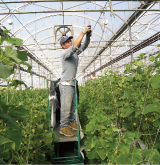 |
| This is the third year Rainbow Acres has utilized the crop lowering production technique, with great results. |
RAINBOW ACRES A MAJOR MINI-CUCUMBER PRODUCER
One of the largest mini-cucumber growers in the region is Rainbow Acres Inc., owned by Kurt and Lina Grass. They have 10 acres at two sites. In addition to the main crop, they’ve also been “some dabbling in mini hot peppers,” Kurt explained.
The smaller, original farm has been in Lina’s family since 1968. “It’s 40 years this month (April) that it’s been in the family,” she noted. It was on that farm that Kurt and Lina began with beefsteak and cluster tomatoes, before diversifying with an acre and a half of mini-cukes. The crop worked so well, they switched entirely over to the new crop.
Two years ago, they acquired a second site of about seven acres.
Why grow mini-cucumbers? “It’s a niche market and we feel we grow an excellent crop,” said Kurt. “Our growing style perfectly matches the growing requirements of the crop.”
Because it’s a relatively short crop of between 12 to 14 weeks, it’s quite challenging. “Kurt is here every day,” said Lina. “Because it’s such a short crop, you could be in a lot of trouble if you have a problem that’s not detected soon enough.”
But the crop isn’t as short as it used to be. Rainbow Farms has switched from the traditional umbrella cropping system to the newer “lowering, or high wire,” system similar to how tomato crops are handled. The move has extended the crop time to 14 weeks, from the previous 10 weeks. “It’s like night and day when comparing the two systems,” said Kurt. “It’s a longer season and a lot more production.”
The longer crop means one less propagation cycle each year. For 10 acres, that adds up to considerable savings.
The lowering system also makes it easier to manage and harvest the crop. The lowering system is much more labour efficient and results in far fewer missed fruit. Under the umbrella system, said Lina, it would be easy to miss fruit high up in the canopy.
The longer crop has also made biological control programs easier to implement. The predators now have more time to settle in. “With a short crop,” said Kurt, “they had a hard time establishing themselves.”
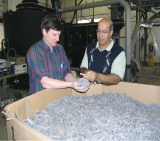 |
| Jim Gallant and Shalin Khosla, with the pellets used in REMASCO’s gasification system. |
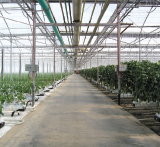 |
| A view down one service corridor in Southshore’s expansive 29-acre pepper operation. |
REMASCO FINE-TUNING NEW PELLET-BASED HEATING SYSTEM
Southshore Greenhouses is home to an innovative alternative energy project being developed by REMASCO (the Renewable Energy Management and Services Company). The firm is developing its own gasification system that will utilize fuel pellets derived from a blend of municipal solid waste and manufacturing residues.
Jim Gallant, an engineer, is directing the project. The pellets, he emphasized, are very clean. They also burn extremely well, yielding about 11,000 BTUs a pound, about the same as coal.
While fuel supply is no problem – REMASCO has access to some 40,000 tons of these pellets per year – the company found no commercial heating system in the size range it needed for its proposed greenhouse program.
No problem. “We decided to build our own system,” said Gallant. It’s a gasification system specifically designed for smaller applications with this kind of fuel.
The three-plenum unit has been thoroughly tested to meet the most stringent Ministry of Environment requirements, and the company is working closely with local municipal councils and industry groups to keep them up to speed. “There’s a lot of interest in what we’re doing,” said Gallant. “For growers, they’re asking about the cost.”
If the technology gets the necessary approvals, REMASCO plans to offer it to growers on a “build-own-operate” basis. The company will install and operate the systems, and charge the growers only or the energy delivered to the greenhouse, Gallant explained. “We’re putting up the capital and we will operate them. We’re supplying the combustibles to operate the system.”
For growers, it will mean a “low-cost, long-term energy” supply. With REMASCO managing the system, it will allow growers “to concentrate on their core business, which is growing plants.”
Some growers working with alternative heating systems have become frustrated with the time and effort required to secure biomass fuels. Others are dealing with material handling issues that require a lot of attention. “We believe we have a fuel that is a very good option for them.”
The technology is also good for the environment, he said. The raw material for the pellets would normally be landfilled.
WATER MANAGEMENT TOOLS FOR GROWERS
Water management is one of the keys to superior yields and crop quality. John Mastronardi, of Sunrise Farms Limited, utilizes a variety of water management tools, including scales, tensiometers, water content meters, and solar radiation readings. “There are advantages and disadvantages with all four of them,” said Mastronardi.
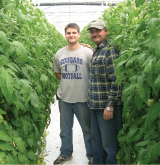 |
| Steve and John Mastronardi, of Sunrise Farms |
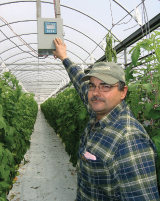 |
| John Mastronardi checks an EC meter. |
Sunrise Farms is a 7.5-acre tomato operation owned by John and his wife, Laura. Helping manage the business is their son, Steve.
Khosla said growers can look at all four tools and determine which of them will best help with their water management decisions.
Mastronardi said the measuring tools help ensure better crop performance. By optimizing the availability of water and nutrients to the plants when they need them most, “you get much better root quality, productivity, yields and plant health.”
Knowing exactly what is going on in the growing media bag is critical. “On a cloudy day, you don’t want to over-saturate the bags. The roots don’t like it, and it can lead to diseases and other production problems.”
On the other hand, on a warm sunny day, “the roots are really working. You almost can’t water too much.”
Now, thanks to his computer readouts, Mastronardi knows exactly how early in the day, for example, he can stop watering without affecting crop performance.
The tools not only improve crop quality, they also help save water, a key consideration within an industry doing its best to conserve water.
The technology confirms what experience usually suggests. Mastronardi has been growing on his own for about 25 years, and grew up working in a greenhouse. Experience, he said, alerts growers to the many “subtle hints” plants give out. “There are a number of shades of green in leaves, and a number of shades of yellow in the flowers.” They all mean different things in terms of plant health.
Water management tools confirm crop conditions. He’s been utilizing them for the past five years. “We’ve seen the results. It’s pretty impressive. When I first started growing with bags, there was some guesswork. Now we have everything in front of us on the computer.”
Print this page